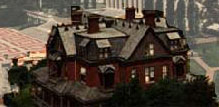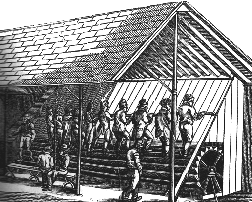Chapter VI excerpts: 1821 - Cadwallader D. Colden, Mayor (Continued)
1822 - Stephen
Allen, Mayor
1821: In this year John Randall, Jr., completed his maps of the avenues and streets of the city as approved by the Commissioners in 1809.  |
| Bloomingdale Asylum evolved from NY Lunatic Asylum opened in 1808 as an extension of NY Hospital. Penal reformer Thomas Eddy's pleas for humane "moral management" of the mentally ill led to its establishment. |
The Bloomingdale Asylum, begun in 1818, was opened on
May 7 in this year.The Deaf and Dumb Asylum, incorporated 1817, was located on Madison Avenue and Fiftieth Street, the present site of Columbia College (1895), first occupied by Columbia in 1857. It was the first asylum for mutes in the United States. . . . .
 |
| British Major John André was captured on Sept. 23, 1780, convicted as a spy in Benedict Arnold's plot to surrender West Point, and executed on Oct. 2, 1780. |
April 10 the British Consul removed the remains of Major
Andre from Tappan to England, pursuant to a request made by the British
Government and the permission which of course was given by the authority
of this country. . . . .
In consequence of the growing frequency of Sunday excursions in steamboats, the clergy of the city entered upon a crusade against them. At a meeting by them at the City Hall, for the purpose of expressing the sense of the community, it was declared there were fully five thousand persons present, and upon the clergy essaying an organization, they were voted down.
|
Background note:
|
|
General Robert Bogardus was a leading member of the New York Bar, a Colonel in the Regular Army during the war of 1812, and toward the close of the war held the responsible position of Commandant of the defences of the city. It is believed that he is the Robert Bogardus who served in the State Senate in 1827.
|
General Robert Bogardus was elected chairman and William T. McCoun (late Vicechancellor) secretary. The meeting then expressed its disapprobation of the interference of the clergy.
The speed of steamboats of the day was very low, ranging
from six to nine miles per hour. The smaller boats, to ports on Long Island
Sound, could not always stem an adverse tide in Hell Gate.
As illustrative of the tediousness of the passage, I note that the owners
of a number of steamboats furnished two thousand volumes of books
for the library of their boats. . . .
In November Beekman Street was extended from Pearl Street
to the river, and the pier at its foot was known as Crane wharf, and on
the 20th of this month Fulton Market was opened for business. In the same
month one of the Brooklyn Ferry sailboats was capsized by collision
and a passenger drowned. . .
December 31. The iron railing for the Park arrived from England, and in order to avoid a duty on the manufacture it was complete only in parts. Four marble pillars to the gateways at its southern terminus were erected and surmounted with scroll iron work supporting lanterns, and also made the depository of coins, etc. Samuel L. Mitchell, M. D., delivered an address on the occasion. . . .
In February [1822] the merchants of the city convened for the
purpose of asking for a floating light off Sandy Hook, also for the formation of an association to construct a Merchants' Exchange. . .
 |
| The treadmill at the Bellevue Penitentiary -- officially "The Penitentiary of the City of New York" -- was said to be the only one of its kind in the state. The female teams of inmates reportedly did better at it than the male inmate teams. |
The wooden picket fence around the City Hall Park having been replaced with one of iron imported from England, our iron
manufactures not being then sufficiently advanced to compete with that
country, trees were set out within the enclosure, and two wellmeaning
and liberal ladies provided rosebushes, which were planted within
the railing, and resisted frosts, the ruthless hand of time, and the wantonness of boys for more than a year. Boys were better behaved then than now.
A treadmill was constructed and operated in the penitentiary by order of the Common Council. It was six feet in diameter and twentyfive feet in length; and by a connection with one end of the shaft, its power was utilized to grind corn.
The custom of burying in Trinity churchyard was discontinued. St. Thomas's Church was built at the corner of Broadway and Houston Street. It was in this year that Congress ceded Castle Clinton (Castle Garden) to the city. . . . .

|
|
The Battery [and Castle Garden].
|
The new Constitution of the State was adopted in February
of this year, whereby there were several important changes. Slavery was
abolished after July 4, 1827, though minors were not to be freed until
1830; the right of voting was given to negroes owning real estate to the
value of $250. Imprisonment for debt was abolished also, to take effect
in May, 1832; military officers were to be elected instead of appointed
by the Governor; and changes in the election laws were effected. The Sheriff, Register, Coroner, etc., were this year for the first time elected, under the provisions of the new Constitution. The election of military officers by their subordinates was a very popular provision and helped toward a great revival of the military spirit. It was not until 1843 that State arms were issued to the National Guard. . . . .
June 17. A case of yellow fever appeared in Lumber, near
Rector Street, and the disease spread so rapidly that by the 26th the occupants of quarters below Wall Street were in headlong flight to Greenwich and other country districts. The public offices, the banks, insurance offices, and newspapers all shifted to what was then the upper part of Broadway or to Greenwich, which place became the scene of hurried building operations on a large scale. . . . What then was known as New York was almost wholly deserted, being fenced off at Wall, then at Liberty, and then at Fulton Street. The ferries from Brooklyn, Jersey City, and Hoboken transferred their landings to Greenwich. Three hundred and eightyeight persons died from the infection, from which the city was not free until the last of October. Such, in prescientific days, were some of the effects of a strictly preventible disease. . . . .
|





